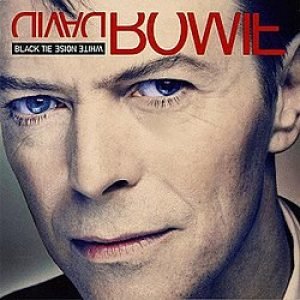When Black Tie White Noise was released in April 1993, it marked a critical turning point in David Bowie’s career. After the mixed reception of his work with Tin Machine and a creative lull in the late ’80s, this album felt like both a homecoming and a new beginning. It was his first solo studio album in six years, and it emerged in a very different musical climate—one shaped by the rise of grunge, hip-hop, and electronic dance music. Rather than chasing trends, Bowie used this moment to reassert his identity, blending older influences with modern textures in a way that didn’t just revisit the past but reframed it for a new decade.
Sonically, the album draws from a wide palette: jazz, funk, soul, house, and electronic music all find a place within its grooves. Collaborating again with producer Nile Rodgers—his partner on Let’s Dance a decade earlier—Bowie sought to create a more complex and nuanced sound. Unlike their previous collaboration, this one wasn’t about chasing chart dominance. Instead, it leaned into mood, atmosphere, and layered instrumentation. The result is a record that feels intimate and cosmopolitan, reflective and futuristic all at once.
At its core, Black Tie White Noise is a deeply personal project. Inspired in part by his marriage to Iman, it bookends the album with instrumental and lyrical tributes to their union. But it also addresses broader themes. The racial tensions in the United States, particularly following the Los Angeles riots in 1992, left a strong impression on Bowie, prompting him to explore ideas of identity, division, and social unrest. The title itself captures this duality—“black tie” as a symbol of formality and celebration, and “white noise” as a metaphor for the background static of racial and cultural conflict.
Sonic Exploration

From the very first notes of Black Tie White Noise, it’s clear that David Bowie was chasing a richer, more immersive sound than what dominated his late ’80s output. The production—helmed once again by Nile Rodgers—is sleek, layered, and highly polished. But it never feels sterile. Instead, there’s a clarity and depth to the mix that allows each element, from the programmed beats to the brass sections, to breathe and shine.
The choice to use both live instrumentation and digital textures gives the album a dual identity: one foot in the analog warmth of soul and jazz, the other in the cold precision of early ’90s electronic music. This contrast perfectly mirrors the album’s tension between intimacy and commentary, love and politics.
Rodgers and Bowie construct each track with care. Take “Looking for Lester,” a jazz-infused instrumental featuring trumpeter Lester Bowie (no relation), where snappy percussion and horn improvisations create a space that feels both spontaneous and meticulously constructed. On the title track, the interplay between synthetic grooves and Al B. Sure!’s soulful vocals builds a bridge between R&B and electronic pop, making the song feel like a conversation between musical cultures as much as a political one.
Vocally, Bowie shifts with intention—sometimes crooning in rich, deep tones, other times allowing himself to drift into a more distant, processed register. His use of backing vocals and harmonies, especially on tracks like “Miracle Goodnight” and “Jump They Say,” adds emotional texture without overcrowding the mix. There’s a deliberate sense of restraint here; the arrangements never overpower the messaging, even when the instrumentation is busy or experimental.
Genre Elements
Genre-wise, the album is a melting pot. There are clear strands of soul, funk, and jazz, but these are interwoven with elements of house, electronic pop, and ambient music. Rather than staying loyal to one genre, Bowie uses each style as a tool to explore different themes. “You’ve Been Around” leans into industrial textures, while “Don’t Let Me Down & Down” touches on Middle Eastern influences, reflecting the global perspective that shaped much of his life at the time.
Lyrical Analysis

Lyrically, Black Tie White Noise captures David Bowie at his most introspective and socially aware in years. The album weaves personal revelations with sharp observations on identity, love, race, and cultural dissonance. While the lyrics don’t always follow a linear narrative, they form a patchwork of themes that reflect Bowie’s state of mind in the early ’90s—a period shaped by personal milestones and a world in flux.
Themes
At the heart of the album is Bowie’s relationship with Iman, which infuses many of the songs with warmth and sincerity. Tracks like “The Wedding” and “Miracle Goodnight” are love letters in sound, full of devotion and emotional clarity. These moments of intimacy are striking, especially from an artist often known for his cryptic or character-driven writing. Here, Bowie lets his guard down, giving listeners a rare glimpse of vulnerability. In “Miracle Goodnight,” he sings with unguarded affection, balancing simple declarations of love with poetic phrasing that gives the track emotional weight without slipping into sentimentality.
But Bowie doesn’t linger too long in personal reflection. The album’s title track tackles racial inequality with a mix of directness and metaphor. “Black Tie White Noise” is a bold attempt to confront cultural divides, using the contrast between high-society elegance and the static of misunderstanding as a metaphor for racial tension. It’s not a protest song in the traditional sense, but it’s a thoughtful and clear-eyed commentary from an artist trying to make sense of a fractured world.
Throughout the album, certain motifs recur—duality, communication, and disconnection. On “Jump They Say,” inspired by the mental illness and suicide of Bowie’s half-brother Terry, the lyrics grapple with instability and the pressures of conformity. It’s one of the album’s darker moments, and its urgent phrasing reflects a man haunted by memory and loss. This track in particular leans more toward abstraction, using fragmented imagery to convey emotional distress and social paranoia.
Lyrical Depth
Bowie’s lyrical style on this album strikes a careful balance between the direct and the enigmatic. Some tracks are emotionally transparent, others veiled in metaphor and symbolic language. This variety in tone and approach keeps the listener engaged, encouraging multiple listens and deeper interpretation. It’s a subtle lyricism—never overly ornate, but never shallow either.
The emotional impact is quietly profound. Black Tie White Noise doesn’t overwhelm with grand statements. Instead, it builds resonance through contrast: love beside fear, unity beside conflict, clarity beside noise. In doing so, it leaves a lingering impression, one that invites reflection rather than resolution.
Cohesion and Flow

Black Tie White Noise moves with a deliberate rhythm, its tracks flowing more like scenes in a film than a linear story. While the album doesn’t follow a strict narrative arc, it creates an emotional and thematic journey that feels intentional from start to finish. The opening and closing tracks—“The Wedding” and “The Wedding Song”—act as thematic bookends, grounding the album in Bowie’s personal life and lending a cyclical shape to the listening experience. These tracks don’t just frame the album musically; they reinforce its core themes of love, commitment, and transformation.
Track Progression
The progression between songs is subtle, and while some shifts are more seamless than others, the album generally maintains a smooth, atmospheric flow. “You’ve Been Around” transitions naturally into “I Feel Free,” offering a blend of brooding electronics and liberated energy that plays with contrasts. Midway through, “Jump They Say” injects a burst of urgency, yet its emotional weight aligns with the more reflective moments that surround it. Even tracks like “Looking for Lester,” an instrumental jazz interlude, don’t feel out of place—instead, they serve as moments to reset the mood while enriching the album’s sonic landscape.
In terms of thematic consistency, the album does an admirable job of threading its ideas across various genres and moods. Whether he’s exploring racial identity on the title track, mourning personal loss in “Jump They Say,” or celebrating love in “Miracle Goodnight,” Bowie remains anchored in a set of emotional truths. The style may shift—soul grooves here, industrial pulses there—but the emotional tone remains cohesive. It’s a work defined not by genre boundaries, but by an overarching mood of contemplation and renewal.
There are moments where the transitions feel slightly abrupt—“Don’t Let Me Down & Down,” for instance, has a more delicate, ballad-like texture that contrasts sharply with the heavier electronic beats elsewhere. But rather than disrupting the album’s flow, these shifts function as breathing spaces, keeping the experience dynamic without losing the central thread.
Standout Tracks and Moments
Among the many layers of Black Tie White Noise, a handful of tracks rise to the surface as particularly impactful—each one showcasing a different facet of Bowie’s creative resurgence.
Jump They Say
“Jump They Say” is arguably the album’s emotional centerpiece. Driven by a tight, funky rhythm and an anxious horn section, the track confronts mental illness and personal tragedy with a sense of urgency that’s both unsettling and compelling. Inspired by the death of Bowie’s half-brother, the lyrics are cryptic yet loaded with emotional tension. It’s not just the content that sets it apart—it’s the way Bowie channels grief and confusion through a sleek, propulsive groove. The moment the saxophone breaks free in the middle section is a release of pent-up emotion, acting almost like a scream in an otherwise restrained environment.
Black Tie White Noise
The title track, “Black Tie White Noise,” stands out for its thematic weight and stylistic blend. It fuses danceable R&B rhythms with a reflective lyrical core, making it one of the most socially conscious songs Bowie had written in years. The call-and-response between Bowie and guest vocalist Al B. Sure! adds depth and dimension, turning the song into a dialogue about racial identity and cultural misunderstanding. This fusion of message and motion feels especially potent, delivering commentary without sacrificing groove.
Miracle Goodnight
Then there’s “Miracle Goodnight”—a lush, melodic ode to romantic devotion. It’s one of Bowie’s most sincere love songs, and it works precisely because of its simplicity. The production sparkles with light synth touches and a tight rhythm section, while Bowie’s vocal delivery is unguarded and warm. There’s an intimacy here that contrasts beautifully with the album’s more cerebral tracks, offering a glimpse of Bowie not as a chameleon or a concept artist, but as a man in love.
Looking for Lester
Another highlight is the instrumental “Looking for Lester,” which offers a jazz-driven detour that still fits squarely within the album’s emotional arc. Trumpeter Lester Bowie brings a spirited, improvisational energy that cuts through the electronic framework, creating a moment of spontaneity in a record that often feels tightly constructed. It’s a small but significant gesture, showcasing Bowie’s willingness to give space to other voices within his work.
The Wedding Song
Finally, “The Wedding Song” deserves mention not just as a closer, but as a moment of quiet revelation. With its layered harmonies and heartfelt lyrics, it encapsulates the personal transformation Bowie underwent during this period. The song’s final moments, with Bowie’s voice floating over gentle instrumentation, feel like a curtain falling—not with finality, but with grace.
Artistic Contribution and Innovation

When Black Tie White Noise arrived in 1993, it did so during a moment of major transition in popular music. Grunge had taken over mainstream rock, electronic music was beginning to dominate club scenes, and hip-hop was asserting itself as a powerful cultural force. In this context, David Bowie’s return was neither retro nor trend-chasing—it was something else entirely: an effort to reconnect with his experimental instincts while staying grounded in his personal and emotional reality.
In terms of genre, the album doesn’t sit neatly within one box. Instead, it stretches across soul, jazz, house, R&B, and pop without ever feeling scattered. This genre-fluidity was not yet the norm in mainstream pop, and Bowie’s ability to weave these influences into a coherent whole made the album stand out. He wasn’t just dabbling—he was curating and interpreting, treating genres as expressive tools rather than rigid categories. This approach placed Black Tie White Noise in a unique position within the early ’90s landscape: it wasn’t part of any major movement, but it offered something that few other records of the time did—a forward-thinking, genre-defying sound from an artist willing to evolve.
Innovation
One of the most innovative aspects of the album is its integration of personal narrative with social commentary. Bowie had always been a shape-shifter, known for crafting personas and mythologies, but here he pulls the lens inward. The juxtaposition of deeply personal songs like “Miracle Goodnight” with politically tinged tracks like “Black Tie White Noise” revealed a more grounded Bowie—one who could be introspective and critical without sacrificing artistry. This thematic balance was ahead of its time, anticipating the kind of emotionally intelligent pop that would gain traction decades later.
Sonically, the album also explored new territory. Bowie’s use of digital production techniques—particularly his fusion of house beats with live horns and jazz improvisation—was unusual for a mainstream rock artist at the time. Tracks like “Looking for Lester” and “Pallas Athena” experiment with form and structure, offering glimpses of what art pop and electronic fusion could become. Even the decision to revisit and rework older songs, such as his cover of Cream’s “I Feel Free,” wasn’t just nostalgic—it was an act of reinterpretation, placing familiar ideas in a radically different soundscape.
Closing Thoughts

Black Tie White Noise is an album of quiet reinvention—less concerned with commercial dominance than with personal and artistic realignment. It finds David Bowie at a crossroads, shedding the weight of a turbulent decade and reconnecting with the emotional and experimental currents that had long defined his best work. The album’s strengths lie in its rich production, genre fluidity, and its willingness to explore themes of love, identity, and cultural tension with both nuance and sincerity.
Its weaknesses, though, are not insignificant. The album’s eclecticism, while artistically brave, sometimes hinders its momentum. Certain tracks, like “Don’t Let Me Down & Down” or “Nite Flights,” while sonically interesting, feel more like stylistic exercises than integral pieces of the album’s emotional arc. The sequencing, though mostly cohesive, has moments where the flow feels interrupted rather than enhanced by variety.
Still, there’s a quiet brilliance in how Bowie navigates these contrasts. He doesn’t strive for grand statements. Instead, he creates a space for reflection, for questions, for personal expression against a backdrop of cultural noise. For longtime fans, this album signaled a reawakening—a Bowie unburdened by persona and reconnecting with the core of his artistry. For new listeners, it offers a gateway into the more understated, emotionally rich side of his catalog.
Official Rating: 7/10
This is not a perfect album, nor does it try to be. But it is a bold, elegant, and forward-thinking effort that shows Bowie regaining control of his artistic voice. A 7 feels appropriate—not as a dismissal, but as a recognition of its ambition and its flaws. It’s an album that rewards patience and repeat listens, and in that regard, it remains a deeply valuable, if occasionally uneven, entry in Bowie’s discography.
